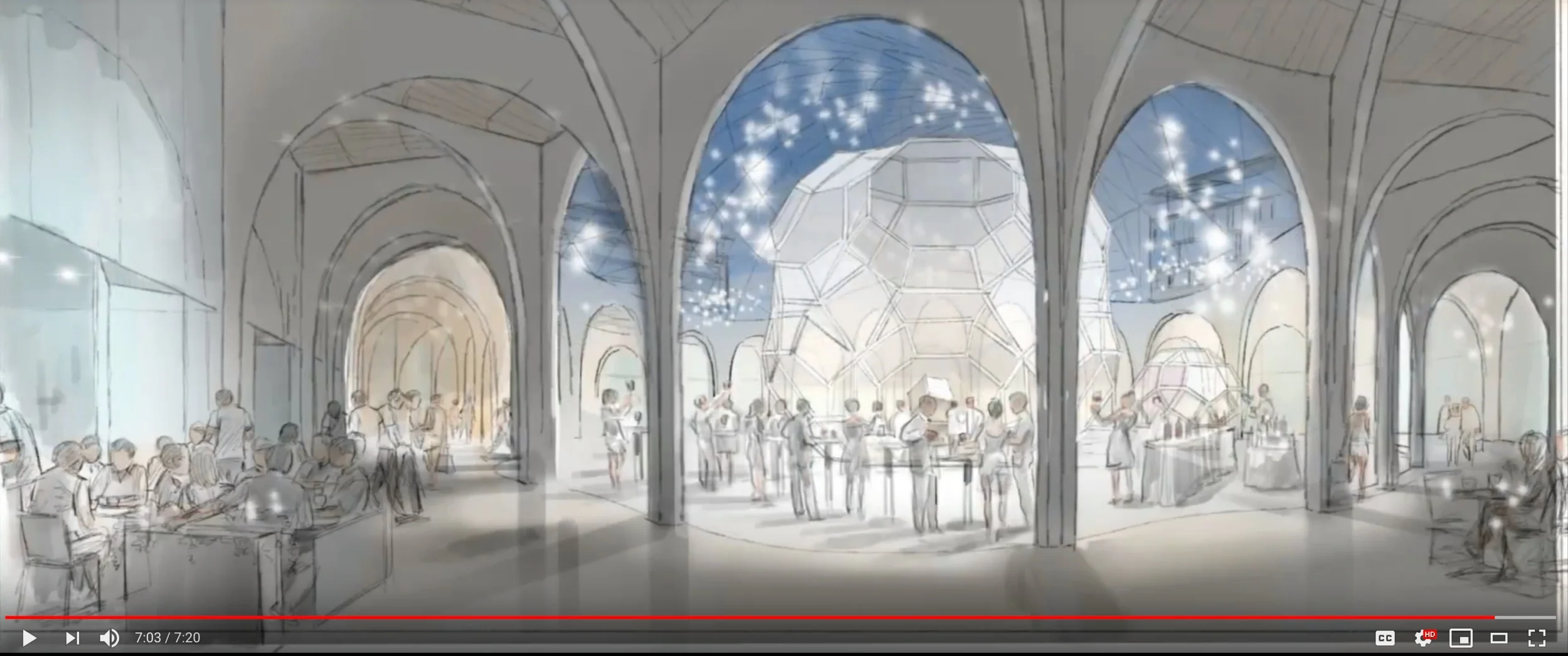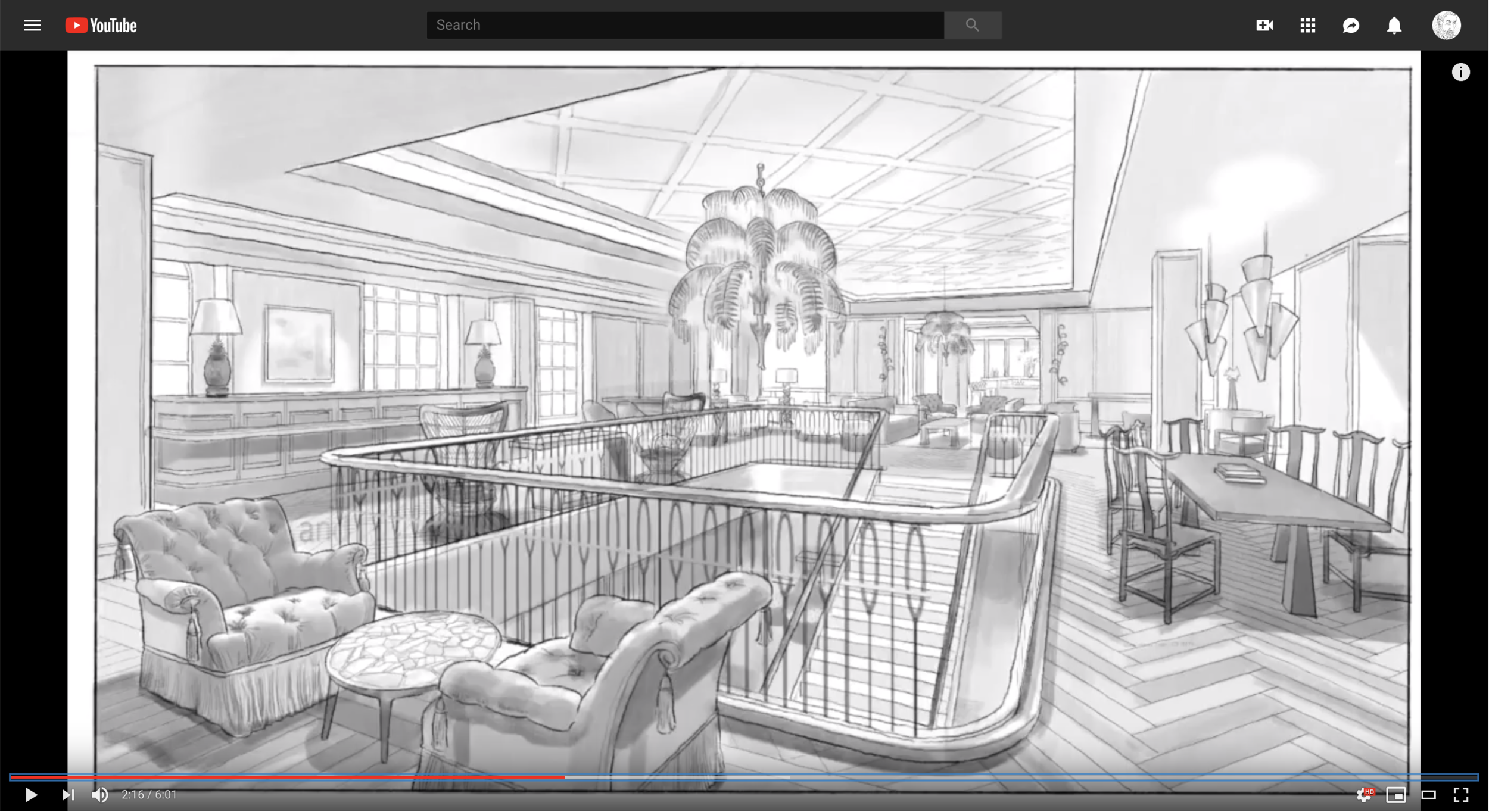In today's masterclass, I show you how quick gestures with Procreate brushes can be all you need to create compelling concept design renderings full of life and energy
The Answer to "What Size IPad Pro Should I Get?" The Biggest and Fastest, Period
Bottom line? Layer management and drawing file size are manageable (for some very conscientious people), but sometimes you need to put technical limits completely out of mind and just draw…fast. With my work, that is more or less every job 24/7/365. And the best hardware for that is the one where speed and storage capacity is state of the art. So if you, like me, have to support yourself with your iPad Pro…
Procreate, Architecture & Design: Sketching as an Essential Step Before Digital Photorealism
Procreate, Architecture & Design: Sketching As Part of the Design and Presentation Process
Procreate, Architecture & Design: Making a "Twilight" Sketch of a Hotel Rooftop in 2 Hours
Getting to Know Procreate's Perspective Assist Tool (1-Minute Masterclass)
Strategic Use of Layers to Make Multiple Versions of a Rendering: Procreate Masterclass
In this video, architect and illustrator James Akers demonstrates how to add hand-drawn life and energy to basic Rhino and Sketchup views, then creates 9 different "events" within the rendering to feature the flexibility and fun of the proposed courtyard design. Thanks for watching and please subscribe for more like this.
Designing Architecture With Procreate: Generating Perspective Sketches From a Plan Photograph
A "Beach" Park for Marseille OM
Procreate Painting and Drawing Techniques for Architects and Designers
Have Pen Will Travel: Benefits To Architects of In-House 3rd Party Sketching and Rendering
Hand Sketching w/ Procreate vs Photo-Realistic Rendering
Using Sketchup and Procreate to Simultaneously Design and Render 5 Hotel Interiors
How Architects and Interior Designers Can Design Using Procreate on the iPad Pro
Using the Procreate App and iPad Pro to Simultaneously Design and Render a Hotel Room by Hand
How Architects and Interior Designers Can Use the iPad Pro, Episode 2: A Rendering in 4-6 Hours
Use Procreate App to Share Short Videos of Your Design Process With Your Clients
Do your clients appreciate how much work goes into your designs? Here's an inexpensive animation technique that can both educate them AND entertain them, burnishing your reputation as a genius while slyly demonstrating to them just how much thought, detail and sweat has gone into producing your designs.
Automatically Collect Every Image You Ever Sent or Received in Gmail
Once you add this extension (or lab feature) to your gmal settings, this amazing code runs quietly in the background to pull a copy of every image you have either sent or received in gmail, going back to the beginning of your gmail life. What's more, it automatically collects these images in a folder you can later find in the left column of your (Mac) finder window (see image below). Its kind of a miracle.
Architectural Presentation Techniques: The Art of the Digital Sketch
In yesterday's post about loose architectural sketches, we talked about traditional pencil and pen-and-ink sketches. Today we'll talk about what I call a loose digital sketch. The loose digital sketch begins with a loose manual sketch composing the view and identifyling the important elements in the proposed design.
But then the loose digital sketch takes a turn to photoshop.


Working closely with the designer, the architectural renderer...
Are You (Or Do You Know) An Unemployed Architect? Don't Start Over, Start Up
(The First In A Series Of Posts About Figuring Out The Next Thing We--And There Are An Awful Lot Of Us--Are Going To Do)
Are you an architect, designer or construction professional unemployed or otherwise disenfranchised by the economy of 2008? (We won't get into the politics, but ask yourself who was in charge from 2000 to 2008?) If so, you, like me, have been trying to figure out what to do. The answer, I believe, is to start up a company. Who better to do this than architects and designers? We're entrepreneurs by nature. We have always worked long hours for little pay (don't you just laugh when you hear investment banking and lawyer friends whine about how hard they worked when they were coming up?) we are born problem solvers, we shun group think, we think about life in philosophical and even metaphysical terms, we welcome chaos, we are skeptical of easy reductionism, and we know how to communicate our ideas in compelling ways. Who better to start up a world-changing business?
Now for the bad news. Statistically there is a 90% chance your start up idea won't work, but if you start off being realistic about that, you won't be too bummed if it doesn't happen. In the meantime, you will have embarked on the most rewarding journey you've taken in years, keeping your mind off unpleasant hypothetical scenarios while reacquainting yourself with everything you were once passionate about. (That, plus an actual reason to spend all day on the internet!)
So how do you start up a start up? (Important: for the purpose of this conversation, starting up a start up counts as a start up. Good, right?) I can only share what my method has been, but it's generic enough that it can't hurt as a place to begin. To those of you who got on this start up thing a year ago, please skip over the material that you're already familiar with. Consider this a table of contents for a series of posts to come. We'll get into detail as we address them.
Coming Chapters Overview:
Find A Pain Point And Solve It (today's entry)
Forget "Regular" Google (despite how awesome this link is): Focus Your Start Up Searching With Podcasts and Google Reader (also partly covered today)
Which Podcasts To Start With?
How (And Why) to use Google Reader instead of Google search
audible.com (because reading pales in comparison to listening during exercise, housework, etc)
Squarespace.com, because you need a blog, not a website
Chris Anderson and his two amazing books Free and The Long Tail
What is the "long tail" of a market and why do I need to know?
Bo Peabody and his awesome book Lucky Or Smart
David Silver's book Social Network Business Plan
What are Foursquare, Yelp, Gowalla, Brightkite, and other social/mobile apps and why do they exist?
What is meant by "mobile" or "social" With Respect To Apps?
What Is The Coming Mobile ayment Revolution?
How Does Google work?
What's An Elevator Pitch
Why Can't My "Deck" Be More Than 5 Pages Long?
What's A Deck?
Where do entrepreneurs live and why?
Why you should...or sholdn't...hire a "business strategist"
How much equity should you give away,and to whom?
What's "domain" expertise?
What's the difference between "friends and family" "angel" and "venture" capital?
Who should be on my start up team (and why do I even need one)?
Where do I get an iPhone app built?
What's Next?
Chapter One: Find a pain point and solve it. Welcome to the most fun phase of starting up a start up. (Enjoy it, 'cause it only lasts for about 3 cocktail parties) In a nutshell, a pain point is a common and compelling problem crying out to be solved. I'm going to contradict myself and expand this point right away because its far and away the most fun. Here is a sample list of pain points and solutions I've explored over the years. When you finish reading, put your idea into the same context. It'll be fun.
Pain Point 1: It's difficult to water my Christmas tree. Solution: The Pournament! an ornament hung at waist level that's really a funnel connected by clear plastic tubing to the water reservoir of your tree, so its easy to fill and doesn't require you getting down on your knees and fighting with spiky, overhanging branches. That, and it tweets when the water level gets too low. (See what I mean about the difficulty of execution? We're 2 minutes into idea 1 and already I have to go find some insane company in Hong Kong that makes a microchip that detects water level and fits inside a fake tree ornament).
Pain Point 2: Half the food in my refrigerator gets shoved to the back and gets all funky before I eat it. That and my shelves are skanky. Solution: The Lazy Susan Refrigerator. Each shelf is a circular lazy susan shelf and you just rotate them to find any and everything and eat it or use it in time. (Does this exist? I don't know, I've never seen it, but wouldn't it be sweet?)
Pain Point 3: It's boring to drive my car down the highway without somehow taking advantage of all that 70 mph wind all up in my luggage rack. Solution: The Carliope, an enormous 8' long x 4' wide mouth organ for the top of your car, similar in concept to an Andean flute (see: Subway Entertainment>New York City> circa 1985) and capable of generating the kind of deep, resonating organ notes and ear splitting volume normally associated with the movie E.T. Dash-mounted keyboard comes as standard equipment. Just imagine riffing on "Inagoddadavida" at 70 mph while barreling through Wilkes Barre on Route 80. Or waking up everyone in the McMansion subdivisions just over the sound-proof barriers lining Route 80 between Morristown and Somerville, NJ. Come one, admit it...it's frikkin' genius.
Pain Point: I live in a large city, and when it gets hot in Summer, the selection of popsicles is always limited to the same boring shapes and flavors. Solution: City 'Cicles, a licensed line of popsicles in the shape of a given city's most famous landmarks. This then leads to a line of popsicle and tray ice molds you can buy and use at home.
OK, got the hang of this? Find a pain point and solve it. Btw, I've got about twenty more ideas like this. Seriously, I can't turn my brain off. Is this an architect thing? I'm telling you...this is fun!
2. Chapter Two: Forget "Regular" Google (despite how awesome this link is): Focus Your Start Up Searching With Podcasts and Google Reader. Google is great, but these days the first few pages of the average Google result can be crap. That's because people who are crappy at their day jobs tend paradoxically to be very good at promoting their sites with SEO. This previous statement is, of course, very unfair, but there is some correlation between becoming slowly dis-enamored of what you do for a living (your website) and wanting to just have more fun promoting your website (SEO). (Did I mention one of the benefits of starting up a start up is that you get to use cool new abbreviations as if you understood them? Just this once I'll spare you a trip to Wikipedia and tell you SEO = search engine optimization. It's the techniques you use to make sure your web page--or your blathering blog posts about architects starting start ups--get noticed and ranked on Google). Anyway, you can get really burnt out searching the first 15 pages of Google results for every one of the many subject areas you're going to need to research for your shiny new start up, and realizing the system has been gamed to death by advertisers and spammers and link farms (see all those cool new words?) will quickly become frustrating. Solution? Podcasts first, then Google Reader.
Podcasts are an unparalleled and, if you find the right ones, incredibly entertaining source for three kinds of information you're going to need to a) figure out who, if anyone, has already done your idea, b) figure out the leading authorities in the domain of your idea, and c) I can never remember the third thing when I make the mistake of stating ahead of time there are three things. There should be an app for that? But seriously, podcasts. Here are several amazing ones that, if your idea has anything to do with tech, you will thank me for:
The twit.tv network was started by a guy named Leo Laporte who is sometimes lovingly referred to (by the geeks that make up the ranks of his guest hosts) as the "president of the internet." It's actually kind of cute--or pathetic?--because, well, what happens as you listen to these things is that you feel as if you're hanging out with a bunch of dweeby kids from high school computer class who made it big, but kept that unique sense of humor that I, for one, have always associated with MIT grads and really smart people that like to walk fast and smell of garlic. I keep as many as possible as friends. The notable geeks that guest host with Leo on these programs include Gina Trappani, Jeff Jarvis, Alex Lindsay, John C. Dvorak, and my two personal favorites, Merlin Mann and Andy Inhatko. Andy is the smart Mac-savvy kid you secretly wanted to be in high school, except you wanted to have a life and a girlfriend and you just couldn't see yourself in a leather hat.
At the other extreme is Jason Calicanis, the host of TWIST (This Week In Start Ups) who, having hailed from Brooklyn, growing up a nerd (and possibly being the kid who was frequently hung up by his jock strap in gym class), moving to the west coast to write about tech, then eventually starting both Weblogs.com and Maholo.com, is such a conflicted mixture of gangsta wanna-be, legit millionaire success and broadcast-sized social dysfunctionalism that it's all you can do to not be mesmerized by the self absorption and drop-dead utility of his weekly hour-and-a-half show. Simply amazing. Btw, start with the episode where he interviews Gary Vaynerchuck. As a start up, you'll be hearing a lot about Gary if you haven't already.
So that's the lovable world of geeks I've been spending far too much time with recently.
Where was I? Oh yeah, podcasts...and Google Reader. Let's do Reader tomorrow, but for now, Podcasts: make them your number one source of information and entertainment for 6 weeks and you will absorb more than you would on straight Google in a year. Seriously. Do this. Now.
--
James Akers
413.250.8800 mobile/text message
www.akersarchitecturalrendering.com (new)



















